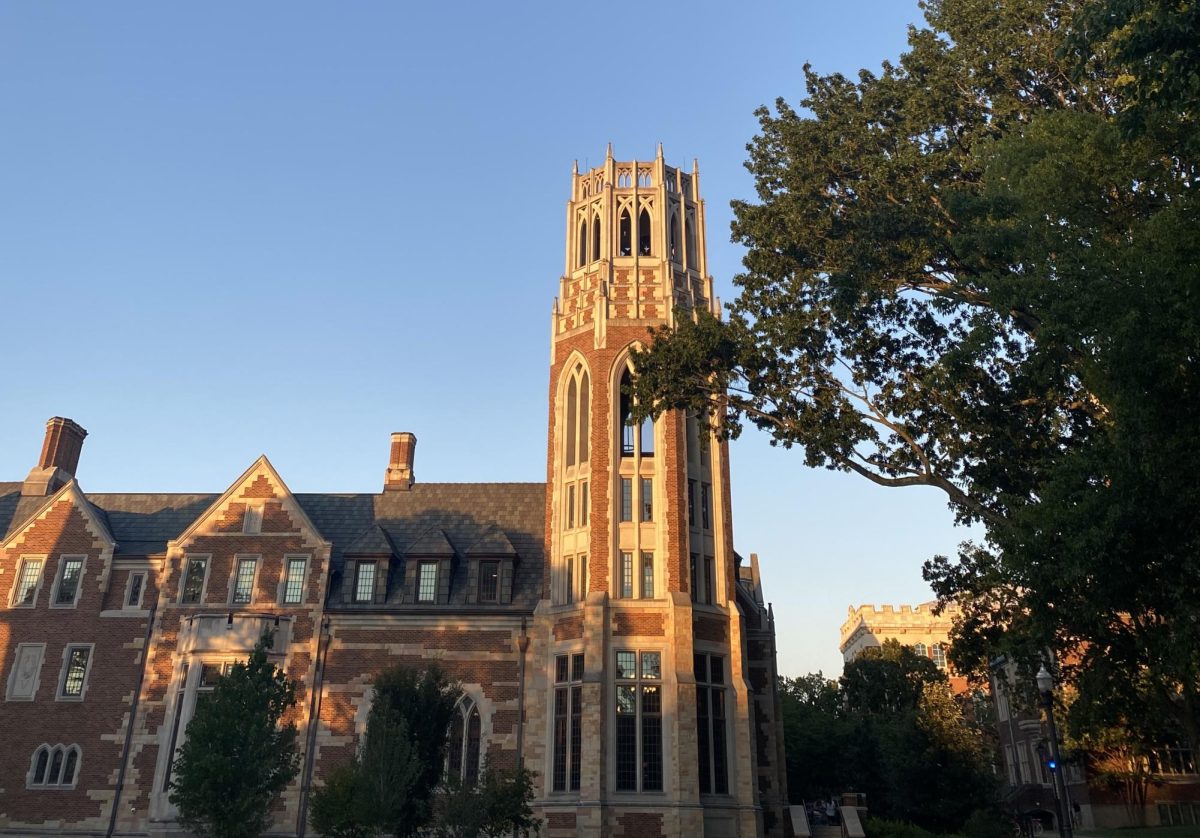
George Albu
E. Bronson Ingram Tower at sunset, as captured on Sept. 3, 2023. (Hustler Multimedia/George Albu)
While Vanderbilt’s first-year acceptance rate hits record lows year after year, a long-standing admissions trend remains: Women have a lower chance of being accepted to Vanderbilt than men. It isn’t clear why.
Vice Provost for University Enrollment Affairs & Dean of Admissions and Financial Aid Doug Christiansen said the Office of Admissions aims for a near-even gender breakdown in first-year undergraduate admissions. More women apply to Vanderbilt than men, resulting in a higher percentage of men being admitted than women. Christiansen failed to explain the importance of this specific balance but emphasized the university aspires to recruit a diverse class.
“I think it’s — when we’re really thinking about — just — there’s — you know — when there’s the demand — and trying to just balance — it’s balanced just so there’s a broad balance of genders on campus,” Christiansen said.
During the past 10 years, Vanderbilt’s largest undergraduate student body gender divide came in the 2013–14 academic year with 52.29% women and 47.71% men.
Although Christiansen specified that Vanderbilt does not set gender quotas in admissions, he said there is an “inference” about how many students of each gender should be admitted to maintain a balanced gender divide in the class.
“There’s a sense of balance that we try to [create], but we do that in a very holistic way,” Christiansen said. “We do look at gender as one piece [of the admissions process].”
In June 2023, the U.S. Supreme Court outlawed race-based affirmative action in college admissions, and racial quotas in college admissions have been outlawed since 1978. However, much less case law exists on gender-based affirmative action and quotas, a topic on which the Supreme Court has never ruled. Title IX prohibits gender discrimination in access to education at schools receiving federal funding but allows gender-based affirmative action at private universities. Despite this exemption, some private universities are still gender-blind in admissions. A handful of states explicitly outlaw affirmative action in public university admissions.
Christiansen emphasized Vanderbilt’s efforts to increase gender diversity in fields traditionally dominated by one gender, such as women in STEM, men in teaching and men in nursing. He said doing so allows for more diverse perspectives in these industries and classrooms.
Gender in first-year admissions
In the past 10 years, more women have applied to Vanderbilt than men, making up around 55% of first-year applicants each year. Christiansen said the gender distribution of Vanderbilt’s applicant pool reflects a national trend of more women applying to college than men. Vanderbilt’s peer institutions all mirrored this trend. He clarified that Vanderbilt is not purposely trying to recruit more male applicants given this pattern, whereas some schools distribute specific marketing materials or invest in sports teams to attract more men.
“At the very highest level, there appears to be a deeper interest [among] women wanting to pursue a college education than men,” Christiansen said.
Men have been accepted at a higher rate than women every year since at least the Class of 2017, before which public data is unavailable. This gender acceptance rate gap has tightened in the past few years despite the stagnant percentage of female applicants.
Christiansen said proportional admissions is not practiced at Vanderbilt and attributed the gender acceptance rate gap to Vanderbilt’s overall competitiveness — implying that men are more competitive than women in Vanderbilt’s applicant pool.
Nationally, the New York Times Magazine reported that girls perform better than boys academically as early as in the fourth grade and as late as high school, have surpassed boys’ standardized test scores in recent years and make up 67% of the top 10% of their graduating high school classes.
“Just because we have more female applicants, I don’t want to give the illusion that if you are a female, that means then you have to be [accepted] at a higher rate. We just have more people that fall in the middle ground who aren’t admissible — whether you’re a man or a woman — just because of the competitiveness,” Christiansen said. “[We’re trying to see] who is the student that we feel will be the best in our community.”
When a handful of Vanderbilt’s peer institutions were prevented by law from employing gender-based affirmative action or gender balancing, higher percentages of women were found qualified to be accepted.
For example, at the University of California-Berkeley, the University of California-Los Angeles and the University of Michigan-Ann Arbor, women were admitted at a higher rate to the Class of 2027 than men despite the schools receiving more female than male applicants. The States of Michigan and California outlaw gender-based affirmative action college admissions at public universities, which includes all three of these peer institutions.
Joining Vanderbilt, two other peer private schools — Dartmouth College and the University of Notre Dame — all had lower acceptance rates for women than men for the Class of 2027.
Vanderbilt hasn’t reported receiving a non-binary first-year applicant in the past 10 years. Dartmouth and Notre Dame also did not report receiving any non-binary applicants to the Class of 2027. Non-binary first-year acceptance rate patterns were inconsistent across Vanderbilt’s peer institutions.
!function(){“use strict”;window.addEventListener(“message”,(function(a){if(void 0!==a.data[“datawrapper-height”]){var e=document.querySelectorAll(“iframe”);for(var t in a.data[“datawrapper-height”])for(var r=0;r